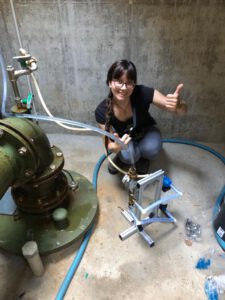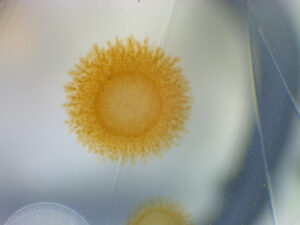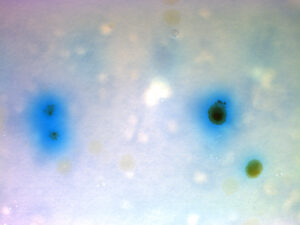In summer 2022, we did a sampling campaign of groundwater wells at the Mörscher Wald waterworks near Karlsruhe. These samples are to be investigated metagenomically as well as used for cultivation.
Sampling at the Mörscher Wald waterworks
The Stadtwerke Karlsruhe (municipal public utilities) supply drinking water to almost half a million people in the city of Karlsruhe and the surrounding area. In order to ensure the supply of drinking water even in times of climate change, a new waterworks was built in the forest of Mörsch, south of the city. It was started up in 2022.
The wells, from which the groundwater for drinking water treatment is extracted, are located in the extensive forest area surrounding the waterworks. The sampled wells access aquifers at different depths, which also means that the groundwater contains different concentrations of various trace elements. The varying occurrance of Manganese is of particular interest for the cultivation of Manganese-oxidizing Bacteria, which is one aim of the MultiKulti project.
Since Manganese must not exceed a limit of 0.05 mg/L in drinking water, the groundwater is treated by filtration. Samples of these filter materials were also provided to the project group at the Technologiezentrum Wasser (TZW Karlsruhe). After treatment, Karlsruhe’s drinking water has a Manganese concentration of less than 0.005 mg/L.
To sample the wells, our staff, equipped with the appropriate safety equipment, descended into the so-called well pits. These chambers are located at the upper end of the well pipe, which contains the pump for extracting the groundwater. The groundwater could be sampled directly via sampling taps and was also enriched on site, i.e. the microorganisms were strongly concentrated by filtration. Later, in the laboratories of the TZW Karlsruhe, DNA in high concentrations was extracted from these enrichments and used to create metagenomes. These metagenomes can then provide information about which microorganisms are present in the groundwater and which metabolic properties they might possess.
Many thanks to Stadtwerke Karlsruhe for making the sampling campaign possible.



Cultivation of Manganese-oxidizing Bacteria
The groundwater was also used for cultivation. One aim of the MultiKulti project is to cultivate Manganese-oxidizing Bacteria from groundwater and filter material, as well as isolating and characterizing individual strains.
Since very nutrient-poor (“oligotrophic”) conditions prevail in groundwater, media with low nutrient content but high Manganese content were used for cultivation. In some cases, these media contained no organic carbon at all, so microorganisms growing on them have to obtain carbon from inorganic carbon compounds like CO2 and grow autotrophically. Yu and Leadbetter showed in 2020 that Manganese-oxidizing Bacteria can be autotrophes.
Since the target organisms grow very slowly, some patience is needed. Some colonies of Manganese-oxidizing Bacteria appear only after eight months on the culture media. Whether they are indeed Manganese-oxidizing microorganisms can be determined using the so-called LBB test. If Manganese oxides are present, the reagent LBB turns to a bright blue (see picture above, see also Jones et.al. 2019). These colonies can then be multiplied by transferring them onto a new agar plate and the colony-forming organism can thereby be isolated. At the TZW Karlsruhe, these isolates are then identified and classified on the basis of their mass spectrum in the MALDI-TOF and by matching their 16S rRNA genes with databases.
Since August, we managed to propagate several Manganese-oxidizing Bacteria from groundwater and filter materials of the Mörscher Wald waterworks, however, their identification and characterization is still pending.
